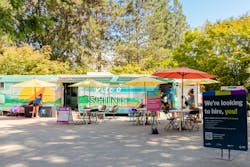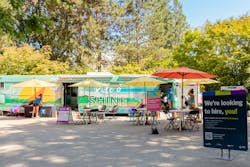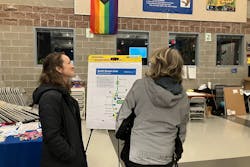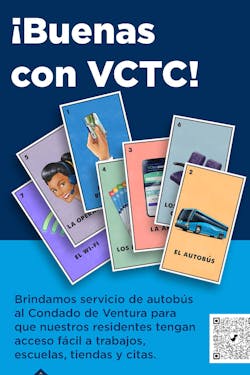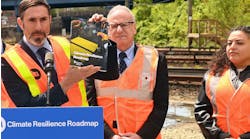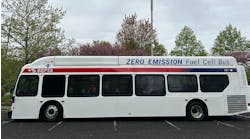For every transit agency, ridership is important. Every agency wants the community they serve to use public transit as their preferred form of transportation, as opposed to burning more fossil fuels with cars.
To increase awareness on the benefits of public transit, agencies have relied more on the community to give critical feedback on its plans to boost their systems. Many of the outreach efforts are used as a way to connect to communities that could be overlooked because of a language or economic barrier.
TransLink in Metro Vancouver, Canada, Community Transit in Everett, Wash., and the Ventura County Transportation Commission (VCTC) in Ventura County, Calif., are just three examples of transit agencies who have used feedback from the community to make changes to their operations in order to persuade residents in their region to use public transit instead of using their cars.
TransLink’s Ride and Shine campaign
In summer 2022, TransLink launched the Ride and Shine campaign to help promote the use of transit, as the region of Metro Vancouver was slowly starting to find its “new normal” in a post-COVID-19 world.
Steve Vanagas, TransLink’s vice president of customer communications brand and public affairs, explains the campaign was launched in summer due to the weather being nice and schools not being in session.
“People love to explore the city, especially during summer,” Vanagas said. “They like to go out with their friends. They go out with their families. They want to go to events and concerts and festivals and what better way to do that than taking transit? That's the message we wanted to send.”
The campaign has led to a 10 percent increase in transit ridership for the agency post-pandemic, helping TransLink lead the way in ridership recovery in the U.S. and Canada. After the first year of the campaign, TransLink conducted intercept surveys, where the agency interviewed 370 people during the course of the campaign across the 15 key corridor routes. The results from the Q&A style survey showed 24 percent of participants said the Ride and Shine campaign encouraged them to try those routes, while 16 percent said the campaign increased their use of transit on those routes.
To promote the campaign, TransLink formed partnerships with businesses and organizations along 15 key corridors throughout Metro Vancouver. The partnerships allowed the agency to offer incentives for using TransLink during the summer months. Incentives included transit passes, as well as non-transit related items such as concert tickets.
When the campaign first launched in summer 2022, TransLink also hosted seven car-free day festivals in communities around the region that attracted 650,000 people.
The Ride and Shine campaign begins when schools are dismissed for the summer break in June and ends when students return to school in September. Vanagas believes the timing of the campaign couldn’t be better.
“No one wants to drive around the city during that time of year,” Vanagas noted. “It's expensive. The cost of living is bad. People are feeling the sustainability challenge. We wanted to encourage people to get out of their cars and come back and use the transit system.”
Community Transit’s community outreach efforts
In 2022 and 2023, respectively, Community Transit won awards from the American Public Transportation Association’s Adwheel Grand Awards for its outreach efforts. In 2022, the agency won the award for its Video Series in Support of Mechanic Recruitment while in 2023, the agency won the award for its Campaign to Recruit Coach Operators for Workforce Development.
Both awards were part of the agency’s outreach efforts for two big projects that will help advance transportation in the region in 2024:
- Sound Transit’s East Link light-rail extension project
- Expansion of Community Transit’s Swift Line to include the Orange Line
For each project, Community Transit engaged in community efforts through surveys, which featured a combination of multiple choice, short answer and comment sections, as well as a virtual open house that featured an interactive map that showed where the proposed station locations were. Participants in the open house could then drop a pin on the map and leave a comment, explaining why they would like a station in a certain area.
Chelsea Ongaro, Community Transit’s community engagement program manager, noted the surveys featured 80 respondents whose native language is not English, something the agency puts an emphasis on, as Snohomish County, the county where Community Transit is located, is home to many Spanish-speaking residents.
“With the big changes coming to our community, we wanted to make sure the needs of those with low incomes and people who speak languages other than English here in Snohomish County were met,” Ongaro said.
The agency conducts major and minor service changes. Major service changes include taking a route away, adding a new route or changing schedules by a significant amount of time while minor service changes include adjusting a schedule by a few minutes.
For major service changes, Community Transit conducts a proposal process six months before the changes occur. The public has an opportunity to comment during the proposal process to make sure their needs are met. For minor service changes, residents can all the agency’s call center and suggest changes to routes.
In October 2022, Community Transit launched the Zip Alderwood Shuttle, which is part of Community Transit’s Innovative Services program, Innovative Services partners with local communities to test new transportation solutions. The programs often serve as a vital connection to existing transit systems, providing access closer to people's homes and destinations and expanding access to transit for more communities.
Ongaro noted the feedback process on the shuttle was an extensive one.
“That process involved a pretty in-depth community engagement process in three other communities in Snohomish County, Arlington Darrington and Lake Stevens,” Ongaro explained. “In each of those communities, we set up a community working group of people from nonprofits, businesses and community members to help provide input on what the transportation needs are. Then, we did a survey about those needs with the whole community that the community working group provided input on the questions in the survey. Then, our teams evaluated all of that information and came up with some solutions for what transportation options could be in those communities.”
A year after the Zip Alderwood Shuttle launched, Community Transit held an engagement period to gather public comment from riders about how they felt about the service, as it was transitioning the service from a pilot to regular service.
With all the surveys, open houses and public feedback Community Transit requests on its services, getting the word out to participate can be tricky. Ongaro notes the agency has found success with webinars.
“With our webinars, people can ask questions and we’ve seen a lot of success in recording them and sharing them later,” Ongaro said.
VCTC’s multiple outreach programs
In 2023, VCTC received the Transit Agency of the Year Award in the Small Operators Awards category by the California Transit Association for its Buenas con VCTC! program and its Youth Ride Free Program and its College Ride Free Program.
The Buenas con VCTC! Program is entirely in Spanish for individuals who speak Spanish -- the second most common language in Ventura County after English -- and is based off the bingo-style game loteria. The program features loteria-esk cards with transit elements such as VCTC buses, bus seats and free Wi-Fi. The goal of the program is to promote transit use for Spanish-speaking individuals, including those who use transit regularly and those who have never ridden transit before.
The College Ride Free Program launched in 2019 while The Youth Ride Free Program was started in 2022. Both programs' goals are to promote transit use among the young population in Ventura County.
The College Ride Free Program has recently expanded to not only include Ventura County, but also two colleges in Santa Barbara County, which is adjacent to Ventura County. The first year of the Youth Ride Free Program produced more than 1 million rides.
For all three programs, VCTC conducted various outreach campaigns through surveys. Martin Erickson, executive director at VCTC, notes surveys have been conducted by the agency long before the launch of the various programs.
“Approximately six or seven years ago, we wanted to dig a little deeper into finding out what the community really wanted and that led directly to the College Ride Program and the Youth Ride Program,” Erickson said.
VCTC relies on social media to get the word out, noting the internet and social media is where the 18-22 demographic heavily lives to find news, but it’s not the only source of promotion.
“When we started the Youth Ride Program, we attended a lot of back-to-school events at different schools throughout the county. We tried to go to elementary schools, middle schools and high schools. We worked with the [Ventura County] Office of Education. We went to all 10 cities in Ventura County. For the College Ride Program, we worked with a community college district. For both programs, we did a public comment for each of the city councils throughout our county and one of those led to a major electronic billboard in Ventura County,” said Claire Grasty, director of public transit for VCTC.
VCTC presented a toolkit to the county’s Office of Education to promote the Youth Ride Free Program, which included the program flyer, social media graphics, videos and suggested text the office could use on their own social media to promote the program. VCTC’s Program Manager for Government Community Relations Darrin Peschka noted promotion for the program was seen on social media by residents even prior to its launch.
VCTC is currently in the middle of planning its short-term transit plan. What is normally a five-year plan, the current plan that is being developed is for nine to 10 years and will take into account feedback from all nine transit operators in Ventura County.
“Doing outreach throughout the community for the short-term transit plan is critical because all these operators are different,” Grasty noted. We recently completed our transit integration and efficiency study. We also have a fair study we’ll be doing, along with a paratransit integration analysis. It does have a robust strategy. The plan for outreach will also include focus groups and affinity groups.”
